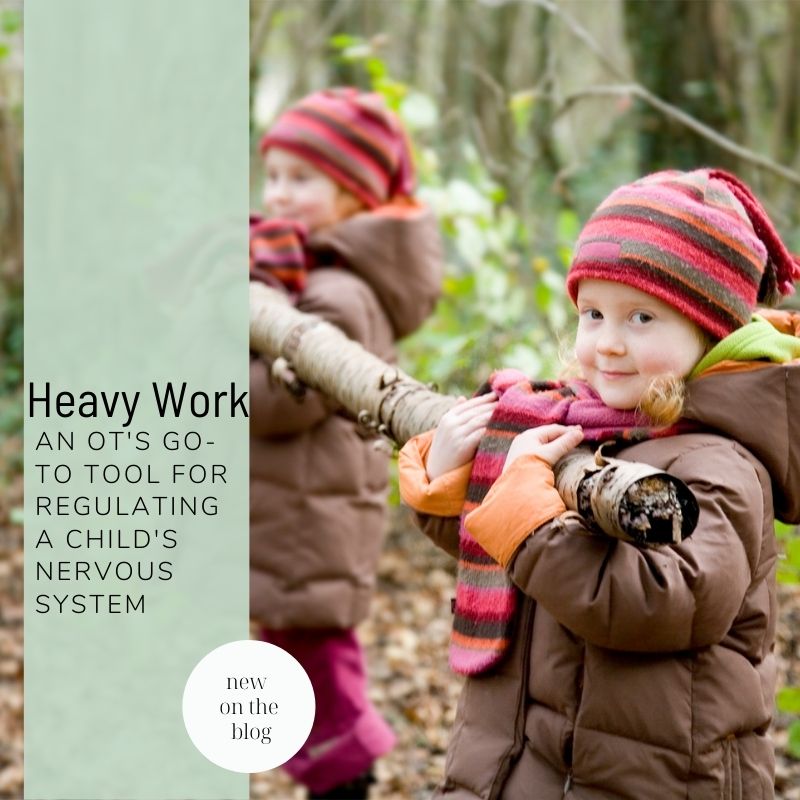Learn what heavy work is, why occupational therapists recommend it to help calm and regulate children and how you can incorporate it into your day.
If you’ve heard the term “heavy work” thrown around before, it might have conjured up an image of a pickaxe and a sweaty brow under a hardhat. But what does it really mean, and what does it have to do with supporting your child’s development?
When occupational therapists talk about “heavy work,” they are talking about activities that activate our proprioceptors, which are sensory receptors used in proprioception.
pro·pri·o·cep·tion
Proprioception is our sensory awareness of a body part’s position relative to the rest of the body. It’s how you are able to touch your nose with your finger with your eyes closed. Proprioceptors also send information from muscles and joints to the nervous system about the force and velocity of movement, allowing you to both pick up an egg without crushing it and twist a little harder to open a stuck pickle jar. It also plays an important role in simple tasks like maintaining upright posture while sitting in a desk chair.
⠀⠀⠀⠀⠀⠀⠀⠀⠀
Heavy work essentially refers to activities that have resistance. This happens when you push, pull, carry, or move against an opposing force. Providing proprioceptive input through heavy work helps to organize the nervous system and calm the body. Doing these types of activities before or after overwhelming moments feel grounding for a child (or adult). Incorporating heavy work into a daily routine can help promote a child’s ability to focus and regulate their emotions.
Here are some suggestions for activities involving heavy work that your child might enjoy:
- Loading a box with soup cans and pushing or carrying it to another room to make a “delivery”
- Pushing or pulling a smaller sibling or friend in a play car, wagon, laundry basket, or sturdy cardboard box
- Doing “wall push-ups”
- Giving a big, firm bear hug to a willing recipient
- Squeezing a stress ball or ball of Play-Doh in their hands
- Popping bubble wrap
- Using a rolling pin while helping a grown-up bake or while playing with Play-Doh
- Climbing on a playground structure
- Hanging from monkey bars
- Playing “librarian” and carrying stacks of books
- Jumping on a trampoline or playing hopscotch
- Doing fun walks (ex: wheelbarrow walks, frog hops, kangaroo jumps)
- Eating chewy or crunchy snacks/food
Here are tools OTs commonly recommend if they feel like your child will benefit from increased proprioception/heavy work:
So what might heavy work look like in your daily routine? Here’s a few scenarios you may have experienced. Your child gets home from school and brings a stormy mood in with him. Or you are getting ready to go into the grocery store with your child where you are hoping your child will not cause a scene. Or maybe your child is excitedly moving around the house really fast, knocking things over and bumping into things and it is time to sit down for a meal.
There’s an opportunity here to think like an OT. Any number of stresses from the day could be amping up your child’s nervous system in a way that’s making it hard for him to regulate right now, whether it was sitting at a desk too long or a funky interaction during lunch. Is there a way to package some heavy work into a fun activity? Maybe an impromptu frog hop race with dad or pivoting your dinner plan to personal pizzas to incorporate kneading and rolling out dough could help things get back on track.
Regularly incorporating heavy work as part of your child’s day can also boost their ability to self-regulate. Experiment with a variety of activities to find favorites and work with your child to make a weekly rotation or list of options to use a few times a day, especially before challenging tasks. For example, if you know your child might have trouble sitting quietly during sister’s afternoon recital, try front-loading the day with lots of heavy work to support a calmer state later.
One way we suggest incorporating heavy work into your routine is writing some heavy work tasks your child enjoys on popsicle sticks and having them draw one from a cup. You can also download our Heavy Work Card Deck for ideas. Your child can look through the deck and choose one or pick a hidden card to flip over to reveal their special task.
Heavy Work Card Preview:










